Accelerated Curing and Enhanced Material Properties of Conductive Polymer Nanocomposites by Joule Heating
Abstract
1. Introduction
2. Materials and Fabrication Methods
3. Results
3.1. Electrical Conductivity of CNT Nanocomposites
3.2. Current Stabilization
3.3. Fast Curing by Joule Heating
3.4. Effect of Joule Heating on Electrical and Mechanical Properties of CNT Nanocomposites
4. Conclusions
Author Contributions
Funding
Conflicts of Interest
References
- Kim, K.H.; Vural, M.; Islam, M.F. Single-Walled Carbon Nanotube Aerogel-Based Elastic Conductors. Adv. Mater. 2011, 23, 2865–2869. [Google Scholar] [CrossRef] [PubMed]
- Qiu, J.J.; Zhang, C.; Wang, B.; Liang, R. Carbon nanotube integrated multifunctional multiscale composites. Nanotechnology 2007, 18, 275708. [Google Scholar] [CrossRef]
- Slobodian, P.; Riha, P.; Benlikaya, R.; Svoboda, P.; Petras, D. A Flexible Multifunctional Sensor Based on Carbon Nanotube/Polyurethane Composite. IEEE Sens. J. 2013, 13, 4045–4048. [Google Scholar] [CrossRef]
- Park, S.H.; Bandaru, P.R. Improved mechanical properties of carbon nanotube/polymer composites through the use of carboxyl-epoxide functional group linkages. Polymer 2010, 51, 5071–5077. [Google Scholar] [CrossRef]
- Lee, G.W.; Park, M.; Kim, J.; Lee, J.I.; Yoon, H.G. Enhanced thermal conductivity of polymer composites filled with hybrid filler. Compos. Part. A Appl. Sci. Manuf. 2006, 37, 727–734. [Google Scholar] [CrossRef]
- Shi, Z.Q.; Radwan, M.; Kirihara, S.; Miyamoto, Y.; Jin, Z.H. Enhanced thermal conductivity of polymer composites filled with three-dimensional brushlike AlN nanowhiskers. Appl. Phys. Lett. 2009, 95, 224104. [Google Scholar] [CrossRef]
- Ishida, H.; Rimdusit, S. Very high thermal conductivity obtained by boron nitride-filled polybenzoxazine. Thermochim. Acta 1998, 320, 177–186. [Google Scholar] [CrossRef]
- Jang, S.H.; Na, S.H.; Park, Y.L. Magnetically Assisted Bilayer Composites for Soft Bending Actuators. Materials 2017, 10, 646. [Google Scholar] [CrossRef] [PubMed]
- Jang, S.H.; Park, Y.L.; Yin, H. Influence of Coalescence on the Anisotropic Mechanical and Electrical Properties of Nickel Powder/Polydimethylsiloxane Composites. Materials 2016, 9, 239. [Google Scholar] [CrossRef] [PubMed]
- Jang, S.H.; Yin, H.M. Effect of aligned ferromagnetic particles on strain sensitivity of multi-walled carbon nanotube/polydimethylsiloxane sensors. Appl. Phys. Lett. 2015, 106, 141903. [Google Scholar] [CrossRef]
- Moisala, A.; Li, Q.; Kinloch, I.A.; Windle, A.H. Thermal and electrical conductivity of single- and multi-walled carbon nanotube-epoxy composites. Compos. Sci. Technol. 2006, 66, 1285–1288. [Google Scholar] [CrossRef]
- Wang, K.; Chizari, K.; Liu, Y.; Janowska, I.; Moldovan, S.M.; Ersen, O.; Bonnefont, A.; Savinova, E.R.; Nguyen, L.D.; Pham-Huu, C. Catalytic synthesis of a high aspect ratio carbon nanotubes bridging carbon felt composite with improved electrical conductivity and effective surface area. Appl. Catal. A Gen. 2011, 392, 238–247. [Google Scholar] [CrossRef]
- Esmizadeh, E.; Yousefi, A.A.; Naderi, G. Effect of type and aspect ratio of different carbon nanotubes on cure behavior of epoxy-based nanocomposites. Iran. Polym. J. 2015, 24, 1–12. [Google Scholar] [CrossRef]
- Bayerl, T.; Duhovic, M.; Mitschang, P.; Bhattacharyya, D. The heating of polymer composites by electromagnetic induction—A review. Compos. Part A Appl. Sci. Manuf. 2014, 57, 27–40. [Google Scholar] [CrossRef]
- Chung, D.D.L. Self-heating structural materials. Smart Mater. Struct. 2004, 13, 562–565. [Google Scholar] [CrossRef]
- Prolongo, S.G.; Moriche, R.; Del Rosario, G.; Jimenez-Suarez, A.; Prolongo, M.G.; Urena, A. Joule effect self-heating of epoxy composites reinforced with graphitic nanofillers. J. Polym. Res. 2016, 23, 189. [Google Scholar] [CrossRef]
- Mas, B.; Fernandez-Blazquez, J.P.; Duval, J.; Bunyan, H.; Vilatela, J.J. Thermoset curing through Joule heating of nanocarbons for composite manufacture, repair and soldering. Carbon 2013, 63, 523–529. [Google Scholar] [CrossRef]
- Kong, Y.N.; Wang, P.M.; Liu, S.H.; Zhao, G.R.; Peng, Y. SEM Analysis of the Interfacial Transition Zone between Cement-Glass Powder Paste and Aggregate of Mortar under Microwave Curing. Materials 2016, 9, 733. [Google Scholar] [CrossRef] [PubMed]
- Ragab, T.; Basaran, C. Joule heating in single-walled carbon nanotubes. J. Appl. Phys. 2009, 106, 733. [Google Scholar] [CrossRef]
- Ragab, T.; Basaran, C. Semi-classical transport for predicting joule heating in carbon nanotubes. Phys. Lett. A 2010, 374, 2475–2479. [Google Scholar] [CrossRef]
- Gautreau, P.; Ragab, T.; Basaran, C. Hot phonons contribution to Joule heating in single-walled carbon nanotubes. J. Appl. Phys. 2012, 112, 103527. [Google Scholar] [CrossRef]
- Jang, S.H.; Yin, H.M. Effective electrical conductivity of carbon nanotube-polymer composites: A simplified model and its validation. Mater. Res. Express 2015, 2, 045602. [Google Scholar] [CrossRef]
- Song, K.A.; Zhang, Y.Y.; Meng, J.S.; Green, E.C.; Tajaddod, N.; Li, H.; Minus, M.L. Structural Polymer-Based Carbon Nanotube Composite Fibers: Understanding the Processing-Structure-Performance Relationship. Materials 2013, 6, 2543–2577. [Google Scholar] [CrossRef] [PubMed]
- Sandler, J.; Shaffer, M.S.P.; Prasse, T.; Bauhofer, W.; Schulte, K.; Windle, A.H. Development of a dispersion process for carbon nanotubes in an epoxy matrix and the resulting electrical properties. Polymer 1999, 40, 5967–5971. [Google Scholar] [CrossRef]
- Chu, K.; Lee, S.C.; Lee, S.; Kim, D.; Moon, C.; Park, S.H. Smart conducting polymer composites having zero temperature coefficient of resistance. Nanoscale 2015, 7, 471–478. [Google Scholar] [CrossRef] [PubMed]
- Xiang, Z.D.; Chen, T.; Li, Z.M.; Bian, X.C. Negative Temperature Coefficient of Resistivity in Lightweight Conductive Carbon Nanotube/Polymer Composites. Macromol. Mater. Eng. 2009, 294, 91–95. [Google Scholar] [CrossRef]
- Chu, K.; Kim, D.; Sohn, Y.; Lee, S.; Moon, C.; Park, S. Electrical and Thermal Properties of Carbon-Nanotube Composite for Flexible Electric Heating-Unit Applications. IEEE Electron Device Lett. 2013, 34, 668–670. [Google Scholar] [CrossRef]
- Woo, J.S.; Han, J.T.; Jung, S.; Jang, J.I.; Kim, H.Y.; Jeong, H.J.; Jeong, S.Y.; Baeg, K.J.; Lee, G.W. Electrically Robust Metal Nanowire Network Formation by In-Situ Interconnection with Single-Walled Carbon Nanotubes. Sci. Rep. 2014, 4, 4804. [Google Scholar] [CrossRef] [PubMed]
- Wang, Z.X.; Volinsky, A.A.; Gallant, N.D. Crosslinking Effect on Polydimethylsiloxane Elastic Modulus Measured by Custom-Built Compression Instrument. J. Appl. Polym. Sci. 2014, 131, 22. [Google Scholar] [CrossRef]
- Lv, J.; Gong, Z.J.; He, Z.K.; Yang, J.; Chen, Y.Q.; Tang, C.Y.; Liu, Y.; Fan, M.K.; Lau, W.M. 3D printing of a mechanically durable superhydrophobic porous membrane for oil-water separation. J. Mater. Chem. A 2017, 5, 12435–12444. [Google Scholar] [CrossRef]
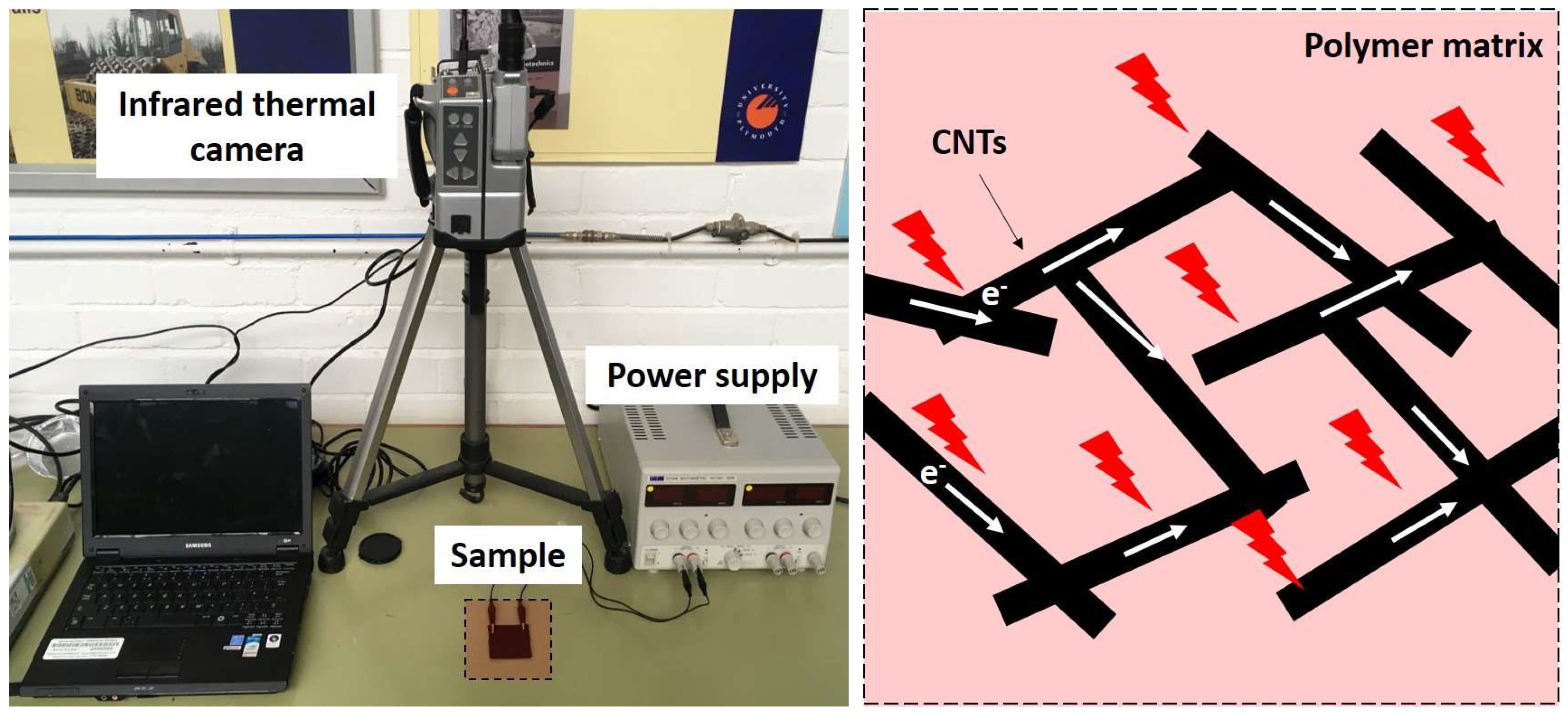
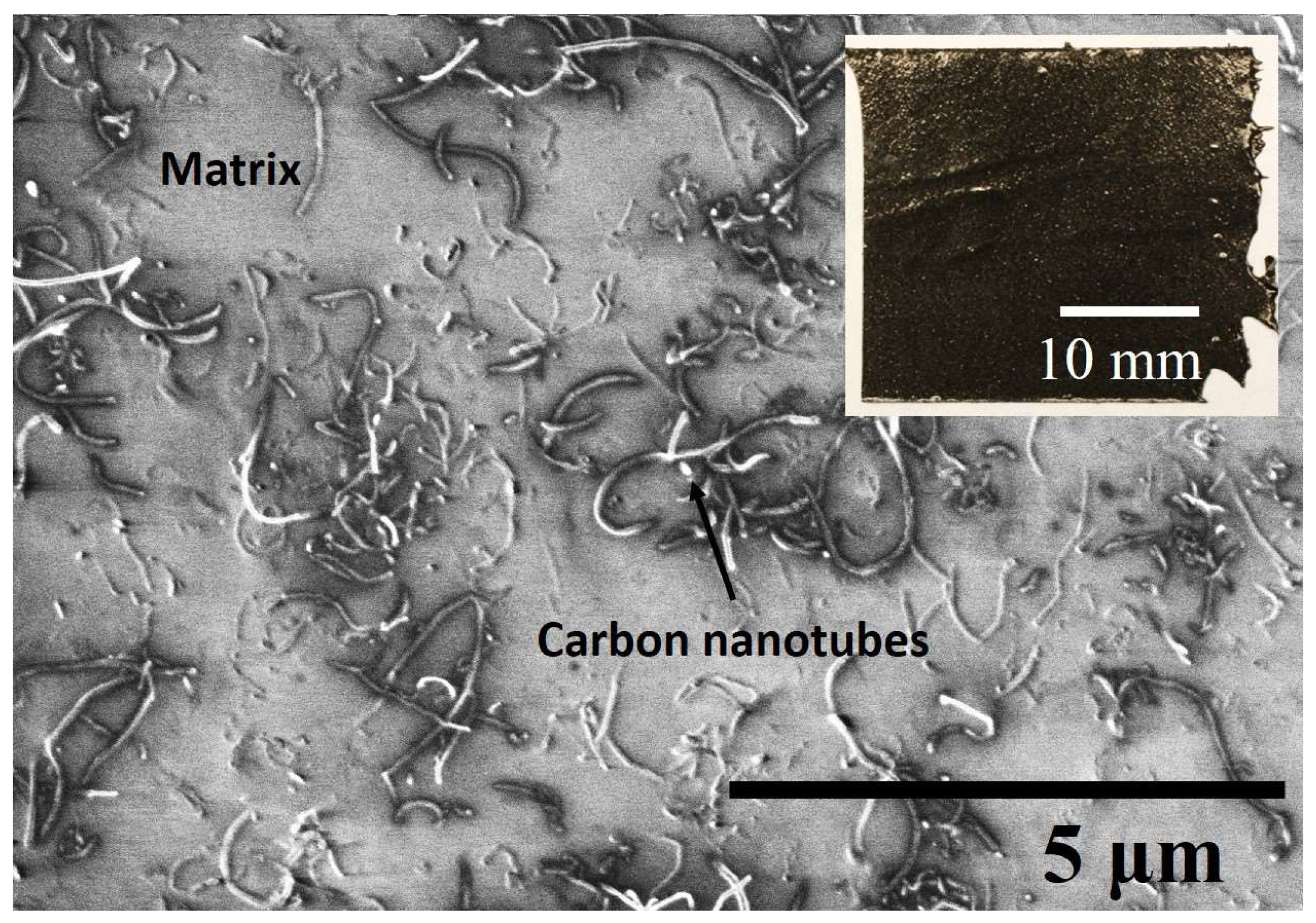

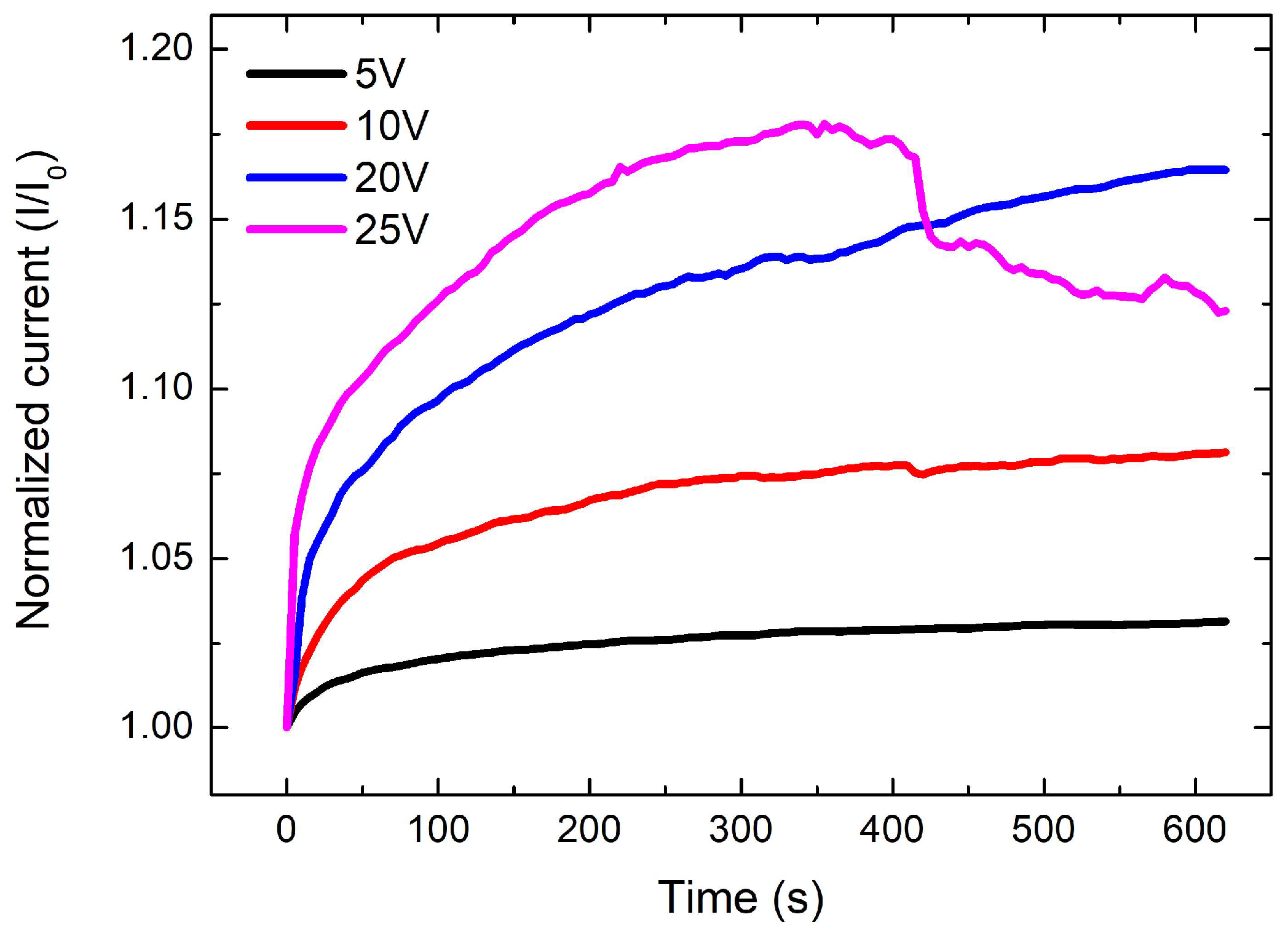
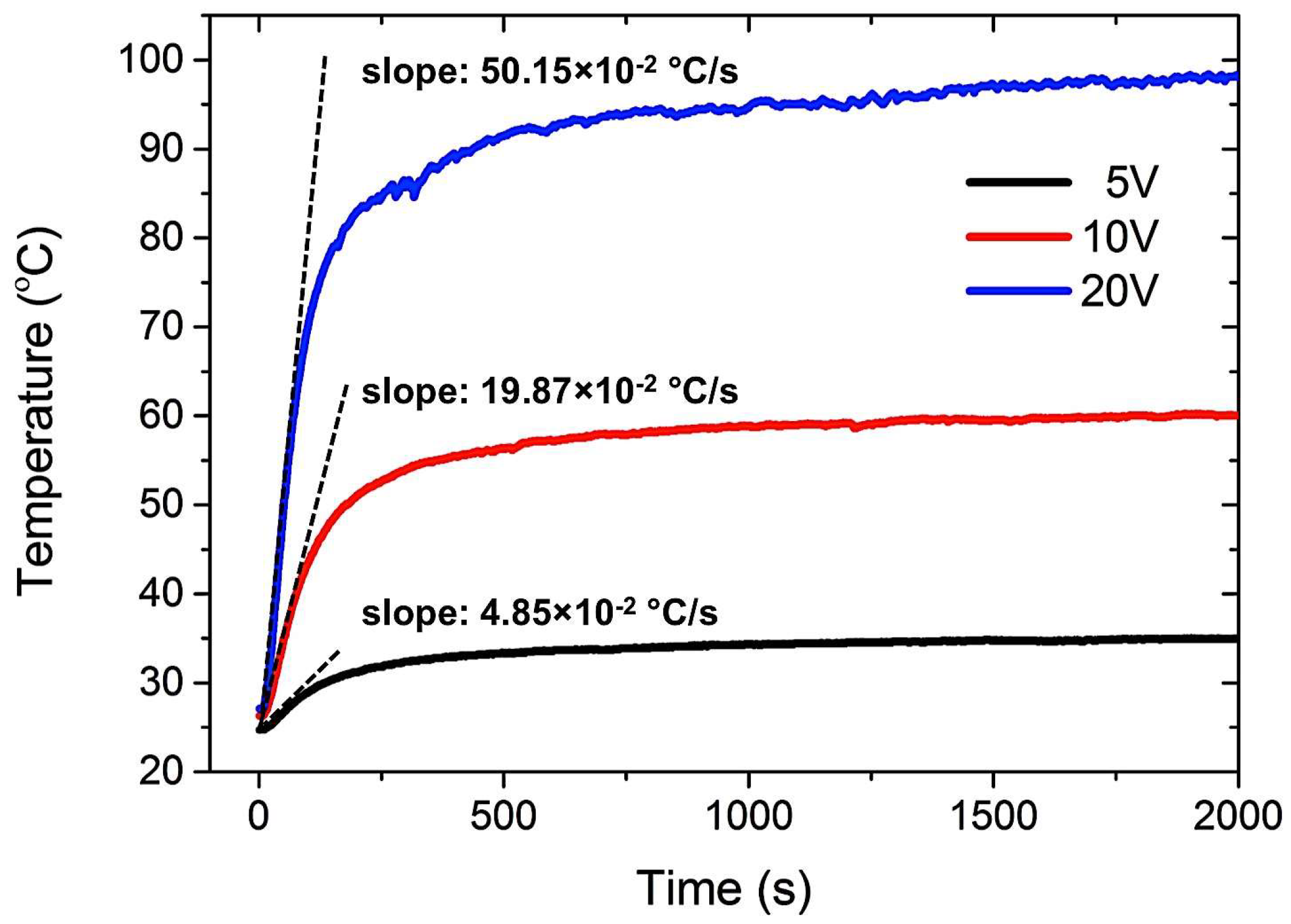


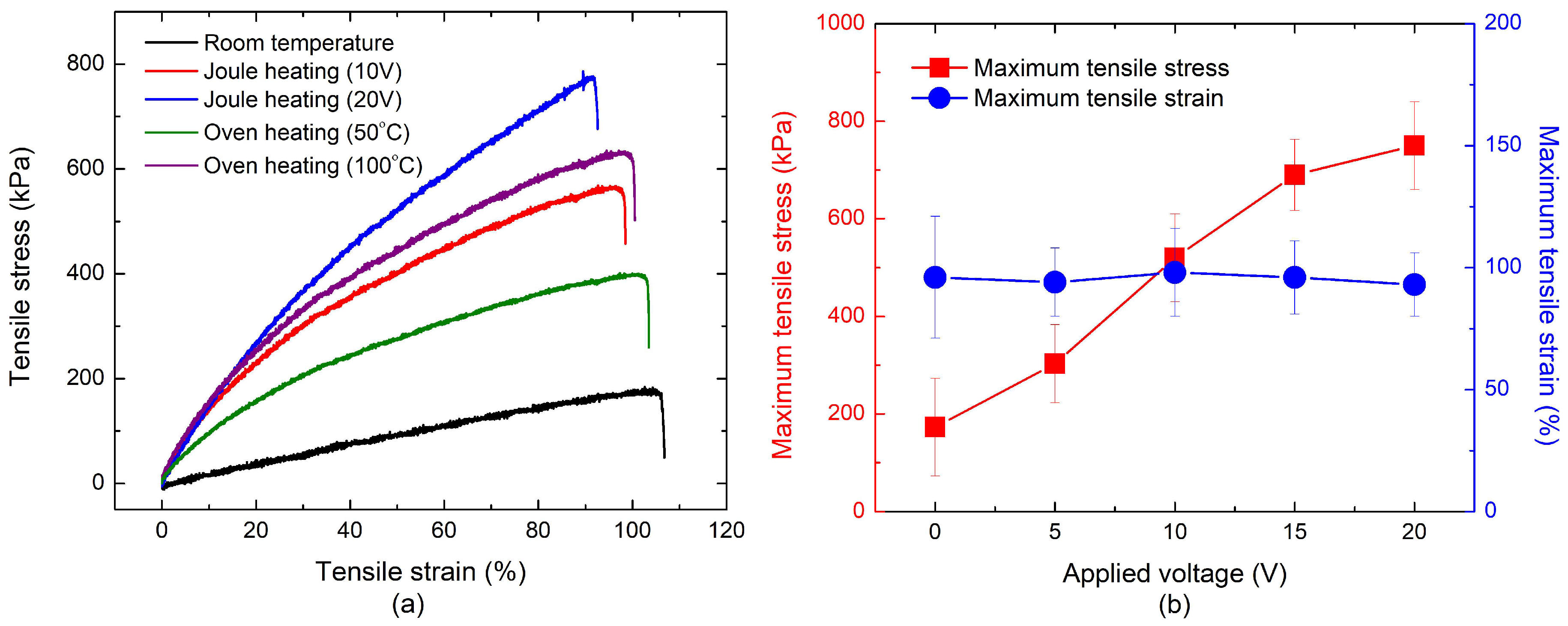
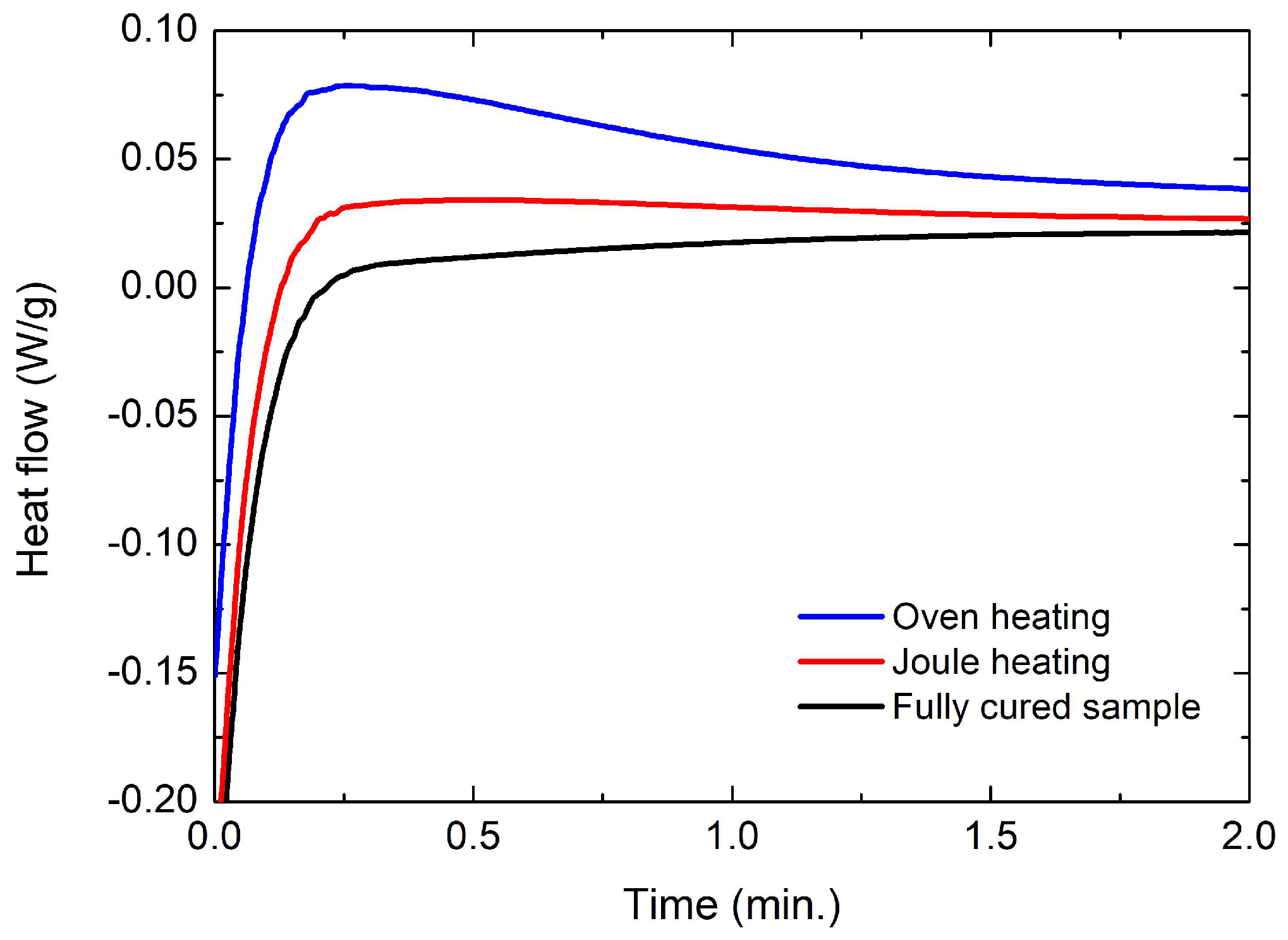
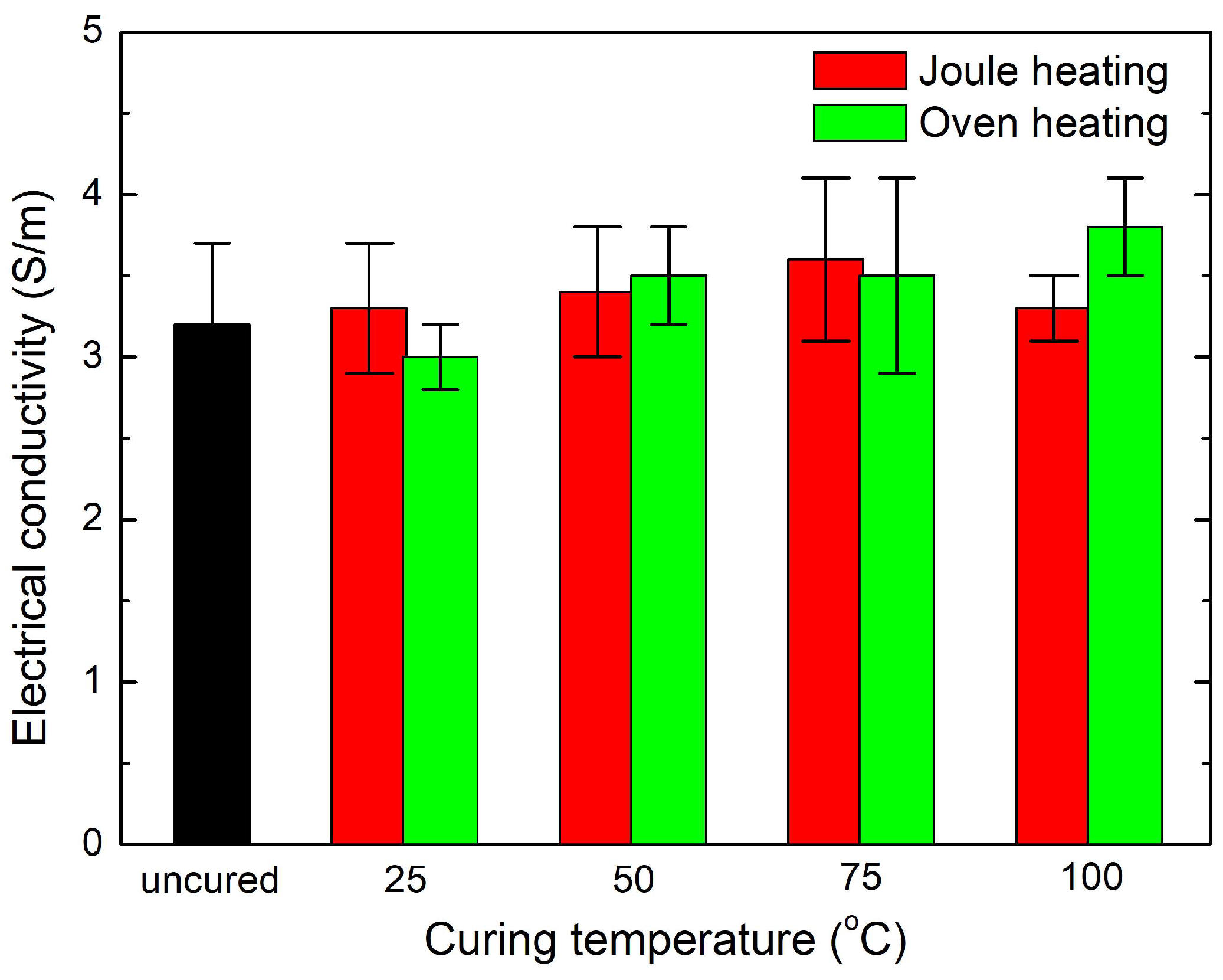
| Applied Voltage | 5 V | 10 V | 20 V |
| Temperature Increase Rate (×10−2 °C/s) | 4.85 | 19.87 | 50.15 |
© 2018 by the authors. Licensee MDPI, Basel, Switzerland. This article is an open access article distributed under the terms and conditions of the Creative Commons Attribution (CC BY) license (http://creativecommons.org/licenses/by/4.0/).
Share and Cite
Jang, S.-H.; Kim, D.; Park, Y.-L. Accelerated Curing and Enhanced Material Properties of Conductive Polymer Nanocomposites by Joule Heating. Materials 2018, 11, 1775. https://doi.org/10.3390/ma11091775
Jang S-H, Kim D, Park Y-L. Accelerated Curing and Enhanced Material Properties of Conductive Polymer Nanocomposites by Joule Heating. Materials. 2018; 11(9):1775. https://doi.org/10.3390/ma11091775
Chicago/Turabian StyleJang, Sung-Hwan, Donghak Kim, and Yong-Lae Park. 2018. "Accelerated Curing and Enhanced Material Properties of Conductive Polymer Nanocomposites by Joule Heating" Materials 11, no. 9: 1775. https://doi.org/10.3390/ma11091775
APA StyleJang, S.-H., Kim, D., & Park, Y.-L. (2018). Accelerated Curing and Enhanced Material Properties of Conductive Polymer Nanocomposites by Joule Heating. Materials, 11(9), 1775. https://doi.org/10.3390/ma11091775





